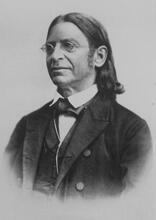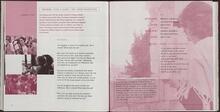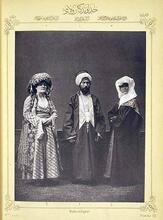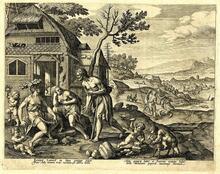Sex
The rabbinic discourse of sex has been simultaneously both empowering and sharply disabling for women. In obliging all women to be wives and mothers, it has severely constrained the possibilities for women’s lives, and to a great extent, women’s roles have been denigrated as well. Through the construction of sexuality as a form of the husband taking care of the wife’s needs and through the construction of her needs as both compelling—and in part inexpressible—male sex-right, forced sexual service for women is achieved absolutely and without sanctioned violence.
Philo’s Ideal Human
In Philo’s interpretation, the ideal human created in Genesis 1 is a purely spiritual androgyne of no sex or gender, while the creation of the human body, divided by sex and engaged in sex, represents a sort of virtual fall. Philo, not surprisingly, envisions a radical destruction of sex as an ideal. In his On the Contemplative Life, Philo describes a Jewish sect, the Therapeutae, living in his time on the shores of Lake Mareotis near Alexandria (Kraemer 1989, 342–370). It is clear from the tone of his entire depiction of this sect and its practice that he considers it an ideal religious community. The fellowship consisted of celibate men and women who lived in individual cells and spent their lives in prayer and contemplative study of allegorical interpretations of Scripture such as the ones that Philo produced. Once in seven weeks the community came together for a remarkable ritual celebration. Following a simple meal and a discourse, all of the members began to sing hymns together. Initially, however, the men and the women remained separate from each other in two choruses. The extraordinary element is that as the celebration became more ecstatic, the men and the women would join to form one chorus, “the treble of the women blending with the bass of the men.” One could suggest that this model of an ecstatic joining of the male and the female in a mystical ritual recreates in social practice the image of the purely spiritual masculo-feminine first human of which Philo speaks in his commentary, indeed, that this ritual of the Therapeutae is a return to the originary Adam (Meeks 1973, 179; Macdonald 1988, 289). Although, obviously, the singing and dancing are performed by the body, the state of ecstasy (as its etymology implies) involves a symbolical and psychological condition of being disembodied and thus similar to the primal androgyne. The society and religious culture depicted by Philo does permit parity between men and women and religious, cultural creativity for women as for men as long as women renounce what makes them specifically female (Clark 1979). Autonomy and creativity in the spiritual sphere are predicated on renunciation of both sexuality and maternity (Harrison 1990, 441–471).
Rabbinic Interpretation: A Dual-Sexed Creature
In sharp contrast to Philo’s interpretation of the ratio between Genesis 1 and 2 stands the interpretation of another group of ancient Jews, the Rabbis. The dominant rabbinic interpretation insisted on the first male-and-female human as a physical hermaphrodite.
According to the midrashic interpretation of the early Rabbis, the primordial Adam was a dual-sexed creature in one body. The story in the second chapter of Genesis is the story of the splitting off of the two equal halves of an originary body:
And God said: Let us make a human, etc. R. Samuel the son of Nahman said: When the Holiness (be it blessed) created the first human, He made it two-faced, then He sawed it and made a back for this one and a back for that one. They objected to him: but it says, “He took one of his ribs (zela).” He answered: “[It means] one of his sides,” similarly to that which is written, “And the side (zela) of the tabernacle” [Exodus 26:20] (Theodor 1965, 54–55; Hasan-Rokem 1996; Baskin 1996, 125–130).
The first Adam, the one of whom it is said that “male and female created He them,” had genitals of both sexes, and the act of creation described in Genesis 2 merely separated out the two sexes from each other and reconstructed them into two human bodies (Robins 1996, 24). Far from gender (and woman) being a secondary creation, we have in the second creation of humanity an Aristophanic (à la Plato’s Symposium) separation of an androgynous pair of joined twins, physically sexed from the very beginning. In the rabbinic culture represented by this text and its parallels, the human race is thus marked from the very beginning by corporeality, difference, and heterogeneity. For these Rabbis, the body and its sexual difference belong to the original created (and not fallen) state of humanity. As is well known, however, together with the body and sexual difference, rabbinic culture seems to inscribe and enforce an inescapable social structure of male domination and nearly total female constriction. The female is not wiped out, rendered insignificant in absorption into a masculine or universal male. The male is not written as spirit (the Phallus) nor the female as body. The female in the rabbinic formation has indeed been “restored to her place and identity”—but with a vengeance! Women, in that formation, can never escape their anatomically destined and single role.
Rabbinic discourse on sex/gender refuses this narrative of one-ness fallen into two-ness, insisting on a two-ness of humanity in the flesh from the very beginning, from the conception by God, as it were. Two sexes exist from the beginning and sexual joining does also. Heteronormativity is thus ontologically grounded within the rabbinic tradition. Rabbinic Judaism thus implacably and oppressively prescribed women’s roles even as it avoided and resisted the essentialist dualism that in the west almost always constructed the spirit as masculine (even in a woman), the body as feminine (even in a man) (Lloyd 1993). Owing to its ironclad insistence on universal marriage (for men and for women), it differentiated gender roles more sharply certainly than Christianity, perhaps even than many cultures have done. When compared with much of historical Christianity we find that within historical Judaism women have been much more powerfully constrained to occupy one and only one position entirely, namely that of wife and mother (Boyarin 1997, xxii–xxiii and passim). Even if any theory of transcendence was already appropriated by the male, there was somehow in the Christian world an opportunity for women to achieve it (Burrus 1987). Not so in Judaism. There are virtually no Jewish equivalents of Thekla, Hildegard, Claire, or even Heloise. While the theory of dualism was lacking, the practice nevertheless confined women exclusively within bodily realms, while men were afforded the realms of the body (sexuality, parentage), the intellect (study of Torah she-bi-khetav: Lit. "the written Torah." The Bible; the Pentateuch; Tanakh (the Pentateuch, Prophets and Hagiographia)Torah), and the spiritual (full religious lives). There was no pregendered, postgendered, androgynous, or even male space for a woman to escape to. A story like the famous one of Yentl (by Isaac Bashevis Singer, 1904–1991), who dressed as a boy in order to study, is exemplary of the frustrations and pain felt by many women in Jewish society as late as the nineteenth century (Boyarin 1997, 143, 172–185). Women were trapped within the category of gender precisely because it was understood as ontologically primary, as definitional for what it is to be a human being.
Feminine Adornment
The distinction between the rabbinic and a typical (if extreme) Christian discourse as the signs of two different configurations of androcentrism can be delineated sharply in the contrast between the Rabbis and Tertullian on clothing and cosmetics (Boyarin 1993). In Tertullian, as in Jerome and many others in the patristic tradition, “Woman” is identified with all that is artificial and merely decorative and thus counter to the purpose of God (Bloch 1987, 11–12; Lichtenstein 1987, 77–88):
That which He Himself has not produced is not pleasing to God, unless He was unable to order sheep to be born with purple and sky-blue fleeces! If He was able, then plainly He was unwilling: what God willed not, of course, ought not to be fashioned. Those things, then, are not the best by nature which are not from God, the Author of nature. Thus they are understood to be from the devil, from the corrupter of nature: for there is no other whose they can be, if they are not God’s; because what are not God’s must necessarily be His rival’s (Tertullian 1989, 17).
Familiar by now is the association of women’s decorations with the devil. For Tertullian, indeed, the evil of women’s adornment lies precisely in that it is inappropriate to the “ignominy of the first sin,” that is for her who is after all “the devil’s gateway” (Tertullian, 14). This virulent antifeminism paradoxically gives rise to a discourse of female liberation. Thus Tertullian states, “Nay, rather banish quite away from your free head all this slavery of ornamentation.” Similarly Clement of Alexandria refers to jewelry as “fetters and chains” (Clement 1989, 269). Indeed, some of the Fathers go further and speak of the unadorned female as the Image of God, which is spoiled by artificial additions. For all of these writers, pregnancy and lactation are also signs of female bondage, and only renunciation of sexuality can free women from these chains: “At the first sound of the angels’ trumpet, the widows will leap forth lightly, easily able to endure any distress or persecution with none of the heaving baggage of marriage in their wombs or at their breasts” (Tertullian, “To His Wife,” 1989, 41). The discourse of disparagement of female sexuality can accordingly become a discourse of female liberation (Clark 1986, 175–208; Schüssler Fiorenza 1983, 90), as in general in early (and later) Christianity sexual renunciation is at least as often imagined as the road to freedom as it is a reaction of contempt for the body (Burrus 1987). Once again, for these early Christian writers, as not for the Rabbis, the human person can be separated from “his” gender via celibacy.
In contrast to this categorical denunciation of feminine adornment, i.e., female sexuality, in the rabbinic culture, ornamentation, attractive dress, and cosmetics are considered entirely appropriate to the woman in her ordained role of sexual partner. Thus a bride even in mourning is permitted/required to use makeup, for otherwise she might become unattractive to her husband. The language of the Hebrew text hides this productive ambiguity by using the participle, which would be roughly translated into English as a present tense, “Mourning women put on makeup in order not to become repulsive to their husbands.” That Hebrew participle incorporates a “permission” that constitutes a fiat. The valorization of the female body and female sexuality is thus precisely the vehicle for the production of “forced sexual service.” Women are similarly permitted/required also to put on makeup on holidays, although painting and drawing are forbidden, because the use of cosmetics is considered a pleasure for them and not work (BT Mo’ed Katan 9b). In the view of Rabbi Akiva, even a menstruant may/must wear her makeup and jewelry in order that she not become unattractive to her husband. That is to say, her sexuality and the external signs of her sexual allure are not suppressed even when menstruating. This is a discourse which in the guise of a valorization of the female body and of female sexuality subordinates women almost entirely to the needs of men.
Sexual Oppression of Women
A rather concise example of how the rabbinic valorization of sexual difference oppresses women can be found, nor surprisingly, in their discourse on desire and speech (Boyarin 1997). Discursive practices related to female desire that appear in Lit. "teaching," "study," or "learning." A compilation of the commentary and discussions of the amora'im on the Mishnah. When not specified, "Talmud" refers to the Babylonian Talmud.Talmud and A type of non-halakhic literary activitiy of the Rabbis for interpreting non-legal material according to special principles of interpretation (hermeneutical rules).Midrash constitute a structure that functions as an equivalent to the “conjugal right” of European legal discourse in terms of the ordering of sexual relations between the genders. The hegemonic rabbinic discourse provides for male sex-right paradoxically through a mystifying construction of women as being in need of sex and of men as being primarily service providers to their wives. The married man was considered by talmudic law under a legal-contractual obligation to sleep with his wife regularly for her pleasure and benefit. This obligation was derived by the Rabbis from the verse of the Torah which, speaking of the taking of a second wife, says that he must not “reduce the flesh, covering or seasons” (Exodus 21:10) of the first wife. This philologically puzzling list was variously interpreted in the midrash, but the hegemonic opinion is that “flesh” means food, “covering” refers to clothing, and “seasons” to regularity of sexual intercourse. This obligation was also made contractual in the standard rabbinically approved marriage contract, which reads, “I will feed you, clothe you, and have intercourse with you, in accordance with the customs of Jewish husbands.” In this context, the Codification of basic Jewish Oral Law; edited and arranged by R. Judah ha-Nasi c. 200 C.E.Mishnah discusses the exact definition of “regularity,” i.e. what constitutes fulfillment of the husband’s sexual debt to his wife.
The Mishnah reads:
If one takes a vow not to sleep with his wife; Bet Shammai say two weeks, and Bet Hillel one week. The students may go away from their homes for study of Torah without permission for thirty days and laborers for one week. The “season” [required frequency of intercourse] which is mentioned in the Torah: for the tayyalin, it is every day; for laborers twice a week; for donkey drivers, once a week; for camel drivers once in thirty days; for sailors once in six months; these are the words of Rabbi Eliezer. (BT Ketubboth 61b)
What is arresting about this discourse is the total mystification that it enacts of male sexual desire and male sexual need. It thus masks almost entirely its own oppressiveness of women and the way that men are securing their own sexual needs here. Christine Delphy’s analysis of the way that men secure “monopoly of a prized commodity,” wine, in rural France through the folk saying: “Femme de vin, femme de rien” provides a germane point of comparison. As Delphy remarks, “[the saying] completely masks the repressive aspect, since it leaves those concerned to be “worthless” and passes in silence over the anticipated benefit of such repression, i.e. the monopoly of a prized commodity” (Delphy 1984, 47–48). The rabbinic passing in silence over the anticipated benefit to men of their caring for their wives’ sexual needs is both like and unlike the case described by Delphy, in that there is here, after all, the provision of what must be, at least fairly often, that which is a benefit (and not a deprivation) for the wife as well.
The The discussions and elaborations by the amora'im of Babylon on the Mishnah between early 3rd and late 5th c. C.E.; it is the foundation of Jewish Law and has halakhic supremacy over the Jerusalem Talmud.Babylonian Talmud on Eruvin 100b includes the following discussion:
Rami bar Hama said in the name of Rav Assi: a man may not force his wife to have sex with him. … (Boyarin 1993, 114–115)
Rabbi Shmuel the son of Nahmani said in the name of Rabbi Yohanan: Any woman who requests sex from her husband will have children such as were not seen even in the generation of Moses. …
It is not accidental that the prohibition on wife-rape and the endorsement of the open expression of female desire are juxtaposed so closely in the Talmud, because the second fulfills a cultural function rendered unfulfilled by the prohibition on wife-rape that the first encodes so unambiguously, namely the securing of male access to female bodies. In other words, the furnishing of a strong religious, cultural incentive (the provision of children of a certain preferred type) for women to desire sex, and, according to this view, to express their desire, obviates the need for patria potestas. This argument is supported by the continuation of the text that proposes, in contradistinction to the cited view of Rabbi Yohanan, that it was the curse of Eve to desire her husband when he is about to go on a journey but to express her desire only through signs of various types and not to openly request sex. This is, moreover, to the best of my knowledge, the only interpretation of the verse “To your husband will be your desire, and he will rule over you” within classical rabbinic texts. A verse that is taken in other, non-rabbinic, Jewish traditions (and much Christian writing as well) to endorse wife-rape is understood by the Rabbis to enjoin on husbands a particular “attentiveness” to their wives’ sexual needs, as a sort of noblesse oblige. Thus although the wife has the right in principle to refuse sex on any occasion, her consent can be understood through silence and necessarily ambiguous signs (Pateman 1989, 76).
As feminists (including, especially for the Jewish context, Laura Levitt) have pointed out, any consent through silence works seriously to reduce its significance as real power and autonomy for women. Moreover, the Talmud has already informed the husband that under certain circumstances, for instance when he is about to depart for a journey, his wife needs him to have sex with her. In other words, through the construction of sexuality as a form of the husband taking care of the wife’s needs and through the construction of her needs as both compelling—and in part inexpressible—male sex-right, forced sexual service for women is achieved absolutely and without sanctioned violence. If, on the one hand, rabbinic legal discourse never construed marriage as an abandonment on the part of the wife of her right to say “no,” on the other, all women, without exception, were expected to be wives.
In fine, then, the rabbinic discourse of sex has been at one and the same time both empowering and sharply disabling for women. In constraining all women to be wives and mothers, the possibilities for women’s lives have been severely constrained and to a great extent, women’s roles have been denigrated as well. On the other hand, in those cultures in which celibate women are celebrated and empowered to perform at their highest level of talent and desire in a whole realm of (religious and creative) activities, the role of the sexualized woman, the wife, can be and has been denigrated even further.
Baskin, Judith R. “Rabbinic Judaism and the Creation of Woman.” In Judaism Since Gender, edited by Laura Levitt and Miriam Peskowitz, 125–130. New York: 1996.
Bloch, R. Howard. “Medieval Misogyny.” Representations 20 (Fall 1987): 1–25.
Boyarin, Daniel. “Carnal Israel: Reading Sex in Talmudic Culture.” In The New Historicism: Studies in Cultural Poetics, vol. 25. Berkeley and Los Angeles: 1993.
Boyarin, Daniel. “Unheroic Conduct: The Rise of Heterosexuality and the Invention of the Jewish Man.” In Contraversions: Studies in Jewish Literature, Culture, and Society. Berkeley & Los Angeles: 1997.
Burrus, Virginia. “Chastity as Autonomy: Women in the Stories of the Apocryphal Acts.” In Studies in Women and Religion. New York: 1987.
Clark, Elizabeth A. “Ascetic Renunciation and Feminine Advancement: A Paradox of Late Ancient Christianity.” In Ascetic Piety and Women’s Faith: Essays in Late Ancient Christianity, 175–208. New York: 1986.
Clar, Elizabeth A. “Jerome, Chrysostom, and Friends: Essays and Translations.” Studies in Women and Religion, vol. 2. New York and Toronto: 1979.
Clement of Alexandria. “The Instructor.” In The Fathers of the Second Century. The Anti-Nicene Fathers, vol. 2. Edited by Alexander Roberts, and James Donaldson, 207–298. Grand Rapids, Michigan: 1989.
Delphy, Christine. Close to Home: A Materialist Analysis of Women’s Oppression. Translated and edited by Diane Leonard. Amherst: 1984.
Fiorenza, Elizabeth Schüssler. In Memory of Her: A Feminist Theological Reconstruction of Christian Origins. New York: 1983.
Harrison, Verna E. F. “Male and Female in Cappadocian Theology.” Journal of Theological Studies 41/2 (October 1990): 441–471.
Hasan-Rokem, Galit. The Web of Life—Folklore in Rabbinic Literature: The Palestinian Aggadic Midrash Eikhah Rabbah (Hebrew). Tel Aviv: 1996.
Kraemer, Ross. “Monastic Jewish Women in Greco-Roman Egypt: Philo on the Therapeutrides.” Signs: A Journal of Women in Culture and Society 14/1 (1989): 342–370.
Lichtenstein, Jacqueline. “Making up Representation: The Risks of Femininity.” Representations 20 (1987): 77–88.
Lloyd, Genevieve. The Man of Reason: “Male” and “Female” in Western Philosophy. Second ed. Minneapolis: 1993.
Macdonald, Dennis Ronald. “Corinthian Veils and Gnostic Androgynes.” In Images of the Feminine in Gnosticism. Edited by Karen L. King, 276–292. Philadelphia: 1988.
Meeks, Wayne A. “The Image of the Androgyne: Some Uses of a Symbol in Earliest Christianity.” Journal of the History of Religions 13/1 (1973): 165–208.
Pateman, Carole. The Disorder of Women: Democracy, Feminism and Political Theory. Stanford: 1989.
Robins, Gay. “Dress, Undress, and the Representation of Fertility and Potency in New Kingdom Egyptian Art.” In Sexuality in Ancient Art, edited by Natalie Boymel Kampen. Cambridge Studies in New Art History and Criticism, 27–40. Cambridge, UK: 1996.
Schor, Naomi. “This Essentialism That Is Not One: Coming to Grips with Irigaray.” In Engaging with Irigaray: Feminist Philosophy and Modern European Thought, edited by Carolyn Burke, Naomi Schor, and Margaret Whitford. Gender and Culture, 57–78. New York: 1994.
Tertullian. “On the Apparel of Women.” In Fathers of the Third Century, translated and edited by Alexander Roberts and James Donaldson. The Ante-Nicene Fathers, vol. 4, ©14–26. Grand Rapids, MI: 1989.
Tertullian. “To His Wife.” In Fathers of the Third Century, translated and edited by Alexander Roberts and James Donaldson. The Ante-Nicene Fathers, vol. 4, 39–49. Grand Rapids, MI: 1989.
Theodor, Jehuda, and Hanoch Albeck, eds. Genesis Rabbah. Jerusalem: 1965.










